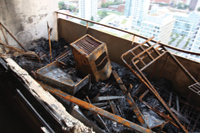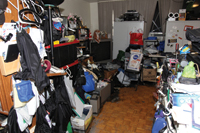
Features
Structural
Training
Trainer’s Corner: December 2010
This issue of Trainer’s Corner looks at the danger that hoarding poses to first responders. The Mayo Clinic defines hoarding on its website as “the excessive collection of items, along with the inability to discard them. “Hoarding,” it says, “often creates such cramped living conditions that homes may be filled to capacity, with only narrow pathways winding through stacks of clutter.”
November 25, 2010
By Ed Brouwer
This issue of Trainer’s Corner looks at the danger that hoarding poses to first responders.
The Mayo Clinic defines hoarding on its website as “the excessive collection of items, along with the inability to discard them. “Hoarding,” it says, “often creates such cramped living conditions that homes may be filled to capacity, with only narrow pathways winding through stacks of clutter.”
We may never understand fully the psychology behind hoarding, but the bottom line that is hoarding is dangerous. A buildup of hoarded items can create unsanitary living conditions. A lack of regular home maintenance can result in the loss of running water, heat or refrigeration, and toilets and sinks may be unusable or inaccessible. Not only is there health risks from airborne pathogens, waterborne pathogens and food-borne pathogens in dwellings where hoarding is present, the accumulation of combustible materials, such as newspapers, clothing and rubbish, can pose a severe fire hazard.
 |
|
| Excessive fuel loads, like those (above) in the unit of origin in a Toronto highrise fire in September, and (below) in another unit in the same building, present considerable challenges for firefighters and emergency workers. Photos courtesy Toronto Fire Services Advertisement
|
|
 |
The volume of combustible materials in a hoarding situation can create an extremely hot, fast-spreading fire that is difficult to suppress. Toronto fire officials say they are worried about hoarding after an apartment fire on Sept. 24 that forced 1,200 people to evacuate a 30-storey Toronto Community Housing complex. The unit of origin, and several others, were found to have extremely high fuel loads.
“The apartment was filled with books and paper at the time of the fire,” said Toronto Fire Chief William Stewart. He said the fire was one of the hottest fires his crews have ever fought, adding that the problem was the “extreme fuel loading.”
In the early 1980s, while living in Orangeville, Ont., I came face to face with a hoarder. As a community pastor I dropped in to visit an older gentleman who was reported to be in crisis. His driveway was lined with an assortment of empty containers. Piles of newspapers, old clothing, trash and a dead (and partially decomposed) cat on a blanket framed the front door. As I knocked on the door, I could see in through the window. The house was filled with newspapers, magazines, empty containers, old clothing, paper, trash and rotting food. The sheer volume was overwhelming. There were two very narrow pathways among the metre or more debris.
Looking back, it is hard to imagine any firefighter doing a room search in these conditions. Not only can the blocked hallways, doorways and windows make escaping a fire impossible, it can critically impede rescue attempts by emergency personnel.
Emergency personnel should also consider that the weight and volume of hoarded items – often stacked from floor to ceiling – can cause structural damage. Flooring can rot with time under piles of garbage and belongings.
And, stacked debris can fall on firefighters. Broken items among the debris can cause injury. There is a high risk of wound infection and disease from the filth, especially if animals and insects are in the home.
Here are some common code violations due to hoarding:
- blocked egress (hallways, stairs)
- fire load (weight of items on the structure of the home)
- fire hazards (items in oven, near heat source)
- trip hazard (fall prevention concerns)
- infestation (insects, rodents)
- plumbing not functioning (health and cleanliness)
- sanitation concerns (rotting food, feces, insects)
When attending fire scenes, the first-arriving officer should be very cautious if there is an extreme collection of items in the yard or along the driveway. There may also be an accumulation of combustible materials (newspapers, magazines and rubbish) near the doorway, on the porch or in the garage. Blocked windows and doorways will hinder the entry and egress of firefighters.
In a hoarding situation, emergency personnel may have to move clutter to reach an injured person and this takes valuable time. If a patient has to be carried out on a stretcher, having to navigate around clutter can cause further delay. In addition, unsanitary conditions can be a serious health hazard for emergency personnel. Dust mites, insects and rodents thrive in clutter. When pet droppings dry and turn to dust, the particles can be inhaled.
While less prevalent, animal hoarding also poses a serious health threat, due mostly to the accumulation of feces, disease and decomposing remains of dead animals. A Google search for hoarding reveals some horror stories: one animal hoarder had 260 cats; one man with 30 cats was found to have toxic levels of ammonia in the air in his house because of all the cat urine.
There are several reports about hoarding on firefighternation.com and backstepfirefighter.com, In one instance, Detroit firefighters had to wade through a hoarder’s collection inside a small private dwelling before making a rescue. Firefighters arrived at the structure and encountered waist-high debris in most places, floor to ceiling in others. Only after the incident did they realize the victim was in a bathroom; all of the contents made the room unrecognizable. The fire, believed to have started in the kitchen, eventually burned through the roof.
In another report, firefighters in Buffalo, N.Y., had no idea they were walking into a raging house fire with propane tanks that had been stored inside; all they had been told was that an elderly man lived there. His car was out front, so crews rushed in and tried to search for him but were told the house was filled with junk and debris, making it tough to move around. Facing one challenge after another, crews were soon ordered out of the house for their own safety and it was on their way out that they noticed and picked up some propane tanks.
“The fire conditions were just horrendous in this one. The wind was blowing; we had a lot of combustibles in there,” said Buffalo Division Chief John Mogavero. “We had some containers of propane; we don’t know what else we had inside. The fire took off and we ended up pulling companies out for the safety of the firefighters at that point since there was nobody inside to search for anymore. We pulled the firefighters out and went defensive on this.”
What if your department encountered a hoarder fire situation? Do you have a plan? What additional resources are available after a working fire is confirmed? Do you have enough manpower to devote to a lengthy search as well as fight the fire? Imagine trying to do a room search when you can’t even get to a wall. What about salvage and overhaul difficulties? What about emergency egress for firefighters?
Please let us in on your department’s experiences with hoarders.
In the meantime, keep training like their lives depend on it, because they do.
Ed Brouwer is the chief instructor for Canwest Fire in Osoyoos, B.C., and the training officer for West Boundary Highway Rescue. The 19-year veteran of the fire service is also a fire warden with the B.C. Ministry of Forests, a wildland interface fire suppression instructor/evaluator and a fire-service chaplain. Contact Ed at ed@thefire.ca
Print this page